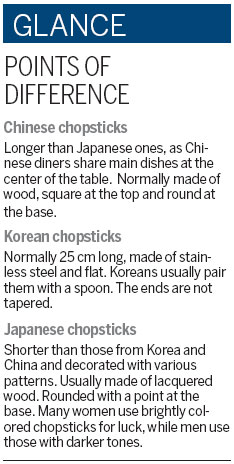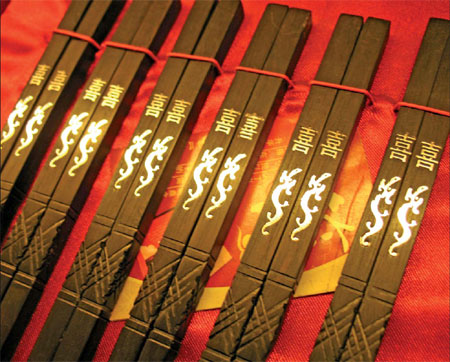Chopsticks corner
Updated: 2012-08-10 10:46
By Zhang Lei (China Daily)
|
|||||||||||
|
Chopsticks are believed to have been developed more than 3,000 years ago in China. Zhang Bo / for China Daily |

Craftsmen hold up humble Chinese utensil
Nestled in Guangzhou's Tiancheng Street, a 7-square-meter workshop looks just like any other store in a common alleyway in the capital of Guangdong province offering traditional utensils to buyers from the nearby community. But stepping into the workshop, subtle scents hit visitors - hints of rosewood, sandalwood, zebrawood and the expensive Huanghuali wood. The owner, Xian Lianguang, is a renowned wood furniture artisan in Guangzhou. And this is his "chopsticks corner".
Unlike the millions of mass-produced chopsticks that are ubiquitous on Chinese dining tables, every single piece of the 61-year-old Xian's creations is made to specific standards and measurements.
His offerings include gold-rimmed plumwood chopsticks engraved with Chinese characters that symbolize goodwill, placed in prominent positions to easily catch customers' eyes. An accompanying card explains that these exquisite chopsticks are exactly like the ones used in grand banquets depicted in the literary masterpiece The Dream of Red Mansions.
On another shelf are Indian rosewood chopsticks, topped with intricate lion heads that boast his most sophisticated techniques.
An old saying in Guangzhou goes: "There will be no throat sore if plumwood chopsticks are used, and no headaches with Indian rosewood chopsticks."
These supposed health benefits that stem from centuries of Chinese chopsticks tradition are just some of the reasons that Xian continues to focus on the fading Chinese craft.
"There are no handmade chopsticks workshops left in Guangzhou," Xian says. "Mine is probably the last one."
Like many traditional crafts and arts that have few members of the new generation to rely on, he was worried that his skills would finally die out. Fortunately for him - and for Chinese chopsticks - his daughter has agreed to receive the baton.
Xian is a third-generation owner who has been making chopsticks for 50 years. As a carpenter, his grandfather opened a furniture workshop in 1889. When he saw there was a lot of wooden trim scraps left, he thought it might be useful to reuse them. He soon started to make chopsticks out of these rare woods and, to his surprise, they became quite popular.
Few will expect that these seemingly simple pieces can actually require seven complex steps to craft and three years to master them.
Xian says he has developed more than 100 kinds of chopsticks with different shapes, sizes and materials. Products range from cheap ones for daily use to expensive pairs for gifts and collection.
Some ordinary-looking chopsticks still do not come cheap: a bundle (10 pieces) of rosewood chopsticks sell at 60 yuan ($9.42, 7.60 euros) while plumwood ones go for 100 yuan.
"These woods are all imported from Thailand, and picking the proper wood is most important, so most of the time I choose them in person," he says. Azobe wood chopsticks are the cheapest products on offer, a pair at 2 yuan.
Xian's rosewood chopsticks have gone as far as the United States since 2003. Restaurants in the Chinatowns there usually book orders of more than 10,000 pieces.
"They like these real wooden chopsticks and they don't like them waxed," he says.
Compared with plastic and bamboo chopsticks, Xian believes his wooden ones are more environmentally friendly and last just as long.
Chopsticks are believed to have been developed more than 3,000 years ago in China. They spread to other Asian cultures, including those in South Korea and Japan, but differ in shape and style. Antiques unearthed from China's ancient tombs show that prior to that, Chinese people used wooden forks, knives and spoons. But they subsequently cut their food into small pieces first, so the knives and forks were soon replaced.
Legend also has it that Confucius discouraged the use of knives and forks at the dinner table because they would remind people of the slaughterhouse.
Back in Xian's workshop, raw pieces of lumber are scattered in the backyard. It is hard to imagine how these scraps are transformed into fine works of art after specific standards of selection, cutting, blasting, planing and polishing.
With increasing environmental awareness and wedding orders, his sales have picked up by at least 30 percent this year.
"Making chopsticks is a complicated art that requires dedication both from your heart and your hands. There is no easy money from it," he says.
Compared with machine-made mass production chopsticks, the length of a handmade chopstick is set at 26.8 cm, with the top of the stick taking on a square shape. Each side is 7.5 mm and the base must be round with a diameter of 5 mm. These measures also reflect good omens in traditional Chinese culture. A chopstick must have a pointed head but not be sharp, in line with the belief that users will "someday come out on top".
"Even carpenters who can make top quality furniture, if not properly trained, cannot make good chopsticks," Xian says.
"Fine pieces in particular require top technique and rich experience. An experienced artisan can craft a chopstick in 10 minutes, but those without training need at least half an hour and cannot meet the standard of every chopstick being of equal size, without missing a single millimeter."
These are exacting standards, but Xian believes they are also the reason why handmade Chinese chopsticks stand to have a bright future in the face of modernity and mass production.
"Mass-produced chopsticks can never be as exquisite," he says.
zhanglei@chinadaily.com.cn
(China Daily 08/10/2012 page24)
Today's Top News
Rescuers race against time for quake victims
Telecom workers restore links
Coal mine blast kills 18 in Jilin
Intl scholarship puts China on the map
More bird flu patients discharged
Gold loses sheen, but still a safe bet
US 'turns blind eye to human rights'
Telecom workers restore links
Hot Topics
Lunar probe , China growth forecasts, Emission rules get tougher, China seen through 'colored lens', International board,
Editor's Picks

|

|

|

|

|

|






